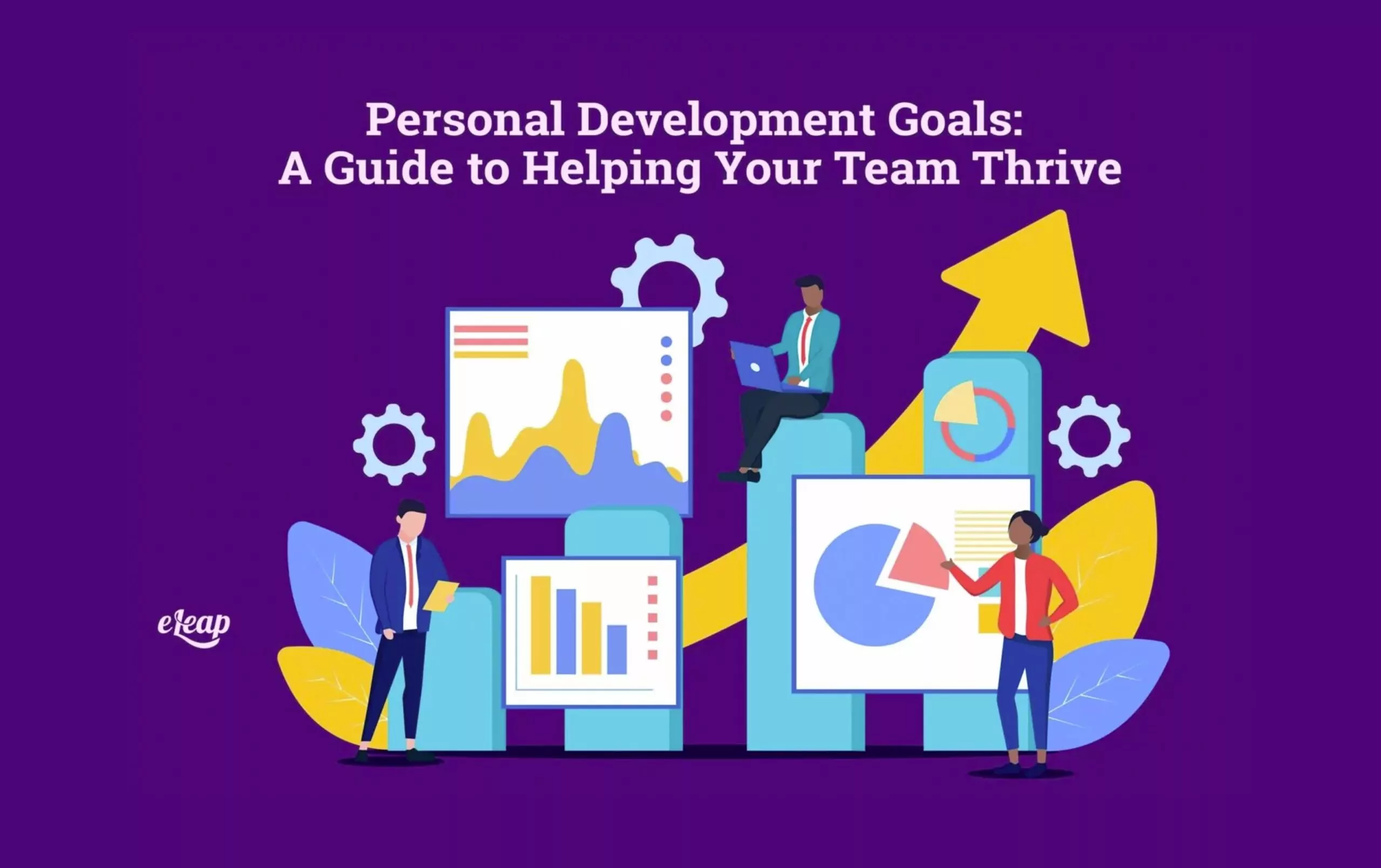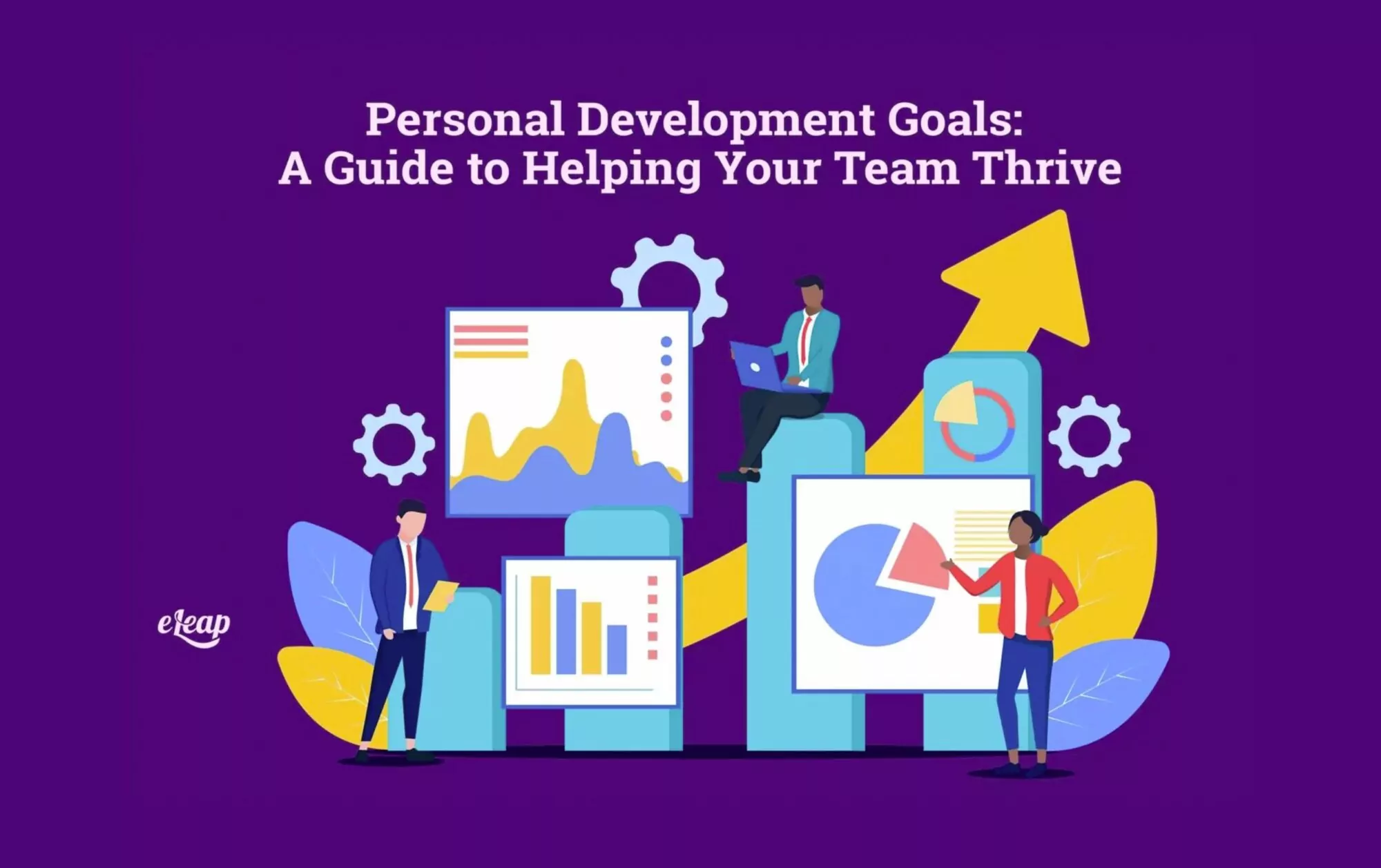Personal Development Goals: A Guide to Helping Your Team Thrive

When it comes to team success, personal development goals are critically important. They provide something to reach toward, as well as milestones by which your team members can gauge their progress. Of course, the challenge is to set meaningful, relevant goals that force team members to stretch to achieve them while remaining realistic.

Not sure how to create personal development goals that fit the bill? It doesn’t have to be a mystery. We’ll explore what you need to know, as well as why these goals are so important in the first place.
Why Do Personal Development Goals Matter?
Goals are important for all aspects of life, from our private lives to our careers to business success. Without goals, we have nothing to strive for – no guideposts to indicate that we’re succeeding in some meaningful way. Goals also give us something to aim at to improve our performance, master new skills, move up the chain of command, and more.
In many ways, goals offer clarification, specificity, and alignment between an organization and an employee’s overall career path. With that alignment and clarification, it becomes possible to retain key talent and then nurture employees over time so that they move up instead of moving on to other employers.
There’s a notion that investing in professional development on the part of employees and helping them achieve those goals is a time and money sink. Many managers and even members of the C suite feel that it only benefits the employee. The truth is that both the employee and the organization benefit. How does helping an employee achieve personal development goals affect your organization?
- Reduced employee churn, which drives down the costs of hiring and onboarding
- Improved employee retention and more experienced employees across the organization
- The ability to become an employer of note recognized for nurturing employees and promoting from within
As you can see, those are extremely pertinent and valuable perks. So, what should you know about personal development goals?
What Makes for Effective Personal Development Goals?
While goals of all types give employees and management something to strive for, not all personal development goals are effective. It’s no different from setting unrealistic or unattainable goals for a team or department. Without the right planning and preparation, those goals won’t be reached and instead of motivating employees, they become a demoralizing force.
How do you ensure that goals are effective? One important metric is to ensure that you’re using SMART goals. If you’re not familiar with it, SMART stands for specific, measurable, achievable, relevant, and time-bound. Why do those qualities matter? Let’s take a closer look.
- Specific – Goals must be specific, not nebulous. Without specificity, it’s difficult to tell when or if you achieve it. State exactly what the goal is.
- Measurable – How will you measure progress toward the goal? How will you measure the impact of the goal?
- Achievable – Make sure that the goal can be achieved with the resources and tools available to the employee within the relevant time frame.
- Relevant – Is the goal relevant to the employee? To their position with the organization? To their future career path? If not, chances are good that it’s not a good fit.
- Time-Bound – What’s the deadline for meeting the goal? Without a firm timeframe, there’s no sense of urgency.
- Ultimately, each personal development goal must have a purpose or meaning, as well. Completing it should mean something for the employee’s future with the organization or overall career path.
Setting Personal Development Goals: Tips and Tricks
Personal development goals come in all shapes and sizes. There’s no way to provide a framework that explains all of them. What’s more, each team member’s goals will likely be different. However, what we can do is provide you with critical tips and tricks to help ensure that your team can set effective personal development goals for themselves.
Clarity Matters
We mentioned that goals can bring clarity to a situation, but to do that, employees need clarity on the goals they set. It’s something of a catch-22 situation. Without clarity in the planning stages, you can’t achieve clarity in the results. As a manager, it’s your job to help employees gain a clear sense of what they want out of their position and even their overall career. Based on that, you can work with them to set effective goals.
How do you do that, though? The first step is to have a conversation with them about their development. This is best handled during a one-on-one, rather than through email or brought up during another type of meeting.
Ask them what skills and tools they might need to become 10% more effective in their job. Ask them what that might look like. Find out what competencies they might need to build to engender that success or to move into a new role.
The point is that you need to work with them to create a vision and then implement a plan to bring that vision to life.
Why Do These Goals Matter?
Another important tip is to help employees define more than just the “what”. They also need to know the “why” behind specific goals. Why does this goal matter? How does it empower them or advance them?
It’s not just about the employees, though. How can these goals help the organization fulfill its mission? It’s important to work with your team members to define the why of things and not just the what. That will lead to goals with greater meaning, as well as a better understanding of the importance of reaching them.
A Strategic Plan
Goal setting is all well and good, but if your employees lack a roadmap that shows them how to get from here to there, those goals are not all that reachable. This is where creating a strategic plan enters the picture. You don’t need to create a plan for them, though. Instead, work with them to create a strategy that dovetails with their overall career focus.
What makes a good plan? Here are a few best practices to keep in mind while you work with team members:
- Goals are reached by completing specific activities
- All activities need to be broken down into milestones
- All milestones need to be broken down into steps
- Each step should have actionable components
In a sense, you’ll be breaking big goals down into smaller ones. This process is also called “chunking” and is used across many different industries to transform what might be insurmountable hurdles into easily accomplished goals. Of course, that means you’ll need to move away from the annual goal mindset.
Instead, take those annual goals and break them up into their constituent parts. For instance, let’s say that one of your team members wanted to move to a leadership position. You have a year to make that happen, but what smaller goals should occur before they can move into that position at the end of a year?
- They should earn any needed credentials over time
- They should lead team meetings of various sizes and purposes
- They should speak with multiple other leaders to learn how they moved up
As you can see, these smaller goals are all about incremental progress. Each one is a small step forward, planned carefully over time, to achieve a very specific goal. Finally, when your team member reaches each goal within the plan, you should provide them with positive reinforcement to keep them motivated and moving forward.
Let Flexibility Be the Guide
The entire point of setting personal development goals is for the employee to achieve them. However, things happen. Projects get derailed. Team members are out sick. It’s all too easy for a plan to get off track, and a goal might not be met within your specified time frame.
Be flexible. Plan for the unexpected, at least as much as possible. It’s also important to realize that sometimes goals might not make as much sense later and you’ll need to be flexible enough to accommodate changing them entirely. Think about the impact of COVID on the world and how many people had to throw in the towel on their 2019 goals.
With flexibility comes the opportunity to adapt and evolve. You may find that the original goal can be reset later, or that the team member is working toward something even more important. Finally, remember that inflexible goals are not effective. During your reviews, if you find that a goal no longer makes sense, adjust and move forward in a way that does.
In Conclusion
In the end, personal development goals give your team members something to strive toward. They motivate and encourage, even while supporting them in developing the skills and capabilities needed on their career path. However, they’re not just important things for the employee – they’re vital for the organization.
With that being said, it’s important that personal development goals are effective, that they’re approached in the right way, and that everyone remains flexible enough to course correct if the situation changes and a particular goal is no longer viable.
Properly planned, these goals help create well-rounded professionals, ensure improved employee retention, and increase the success of your organization.
The eLeaP Performance Management Platform, which includes a continuous performance management system, provides organizations with powerful options to attract and retain high-caliber team members.